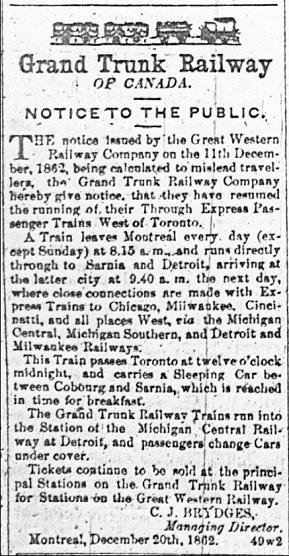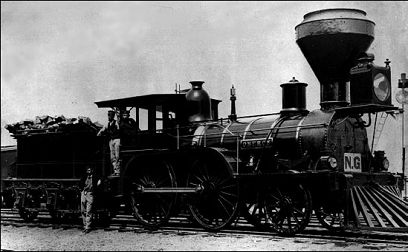 |
||
|
VII. CHARLES H. CAVERLY c.1824-1869 Charles H. Caverly was born in 1824 in the Town of Marlborough, Ulster County, NY to Philip, Jr. and Maria (Clark) Caverly. He moved with his father and siblings to Hastings County, Ontario in 1837. His mother Maria may have already died. About 1846 he married Rebecca Smith, daughter of Matthias and Rebecca (Rouse) Smith who lived three lots away on Concession 4 of Rawdon Township. Charles and Rebecca had seven children; Redford, Cinderella, Mary Melissa, Marshall, Joseph, William, and Allen. All but Allen were born in Rawdon Township, Hastings County, Ontario. Allen was born in Michigan. On Hastings Co., Rawdon Twp., Ontario Land Instrument #C129, Charles took out a mortgage from his father for $800 for 50 acres of the north part of the West 1/2 of the East 1/2 of Lot 9, Concession 4 which he was buying from his father. The 1861 Canadian Agricultural Census for Charles shows he had 30 acres in crops, 10 in pasture, 1 in orchards or gardens, and 9 in woods or wild. Value was given as $1,400 with $50 worth of implements. He also had 4 steers or heifers, 2 milch cows, 2 horses, 4 sheep, and 4 pigs with a total value of $200. They had also produced 100 pounds of butter and 1 200 pound barrel of pork. Charles’ father had died in December of 1860 and left everything to his second young wife except for five shillings each to the children of his deceased first wife. Charles was probably not able to support his family on the 50 acres and there is an 1865 notation on the mortgage (now held by his stepmother) that Charles had defaulted due to desertion. Around 1864 Charles, Rebecca, and family moved to Deckerville in Sanilac Co., MI. By 1859 The Grand Trunk Railway of Canada extended all the way from Maine through Montreal to Toronto and from there to Sarnia. A ferry service had been established across the St. Clair River to Port Huron, MI which at that time had a population of approximately 5,000 people. From Belleville, Ontario just south of Rawdon Township, the GTR had a Day Express leaving at 7:30 P.M., a Night Express leaving at 5:50 A.M., Due to his father’s illness, the oldest son Redford was prevented from enlisting for Civil War service. When news came that General Grant had taken Richmond, VA in July 1865, Redford was helping to build the first docks at Forestville, MI on Lake Huron. michigan@thecaverlys.com If you would like to view the PDF format click here
|
|
| Home - Chat - Forum - Email - The Family | ||
| Copyright 2007 TheCaverlys.com. All Rights Reserved. | ||

 and a Mixed Train leaving at 10:00 A.M. all heading west per a Dec. 1863 schedule. To the right is an advertisement from the Dec. 1862 Belleville Intelligencer weekly newspaper. Charles and family could have come to Michigan via boat on the Great Lakes but the train would have been faster. Below is a GTR locomotive of the 1860s. Charles may have been enticed to come to Michigan because the Civil War had created a labor shortage of young men. In 1862 David Munger, the U.S. consular agent at Windsor, Ontario wrote to William Seward that Michigan businesses were suffering but the men in Canada were fearful that they would be pressed into the war. Seward replied that there would be no restrictions on travel between the U.S. and Canada and that Canadian men did not have to fear conscription. Between 1860 and 1870, Michigan’s Canadian born population increased by 50,000.
and a Mixed Train leaving at 10:00 A.M. all heading west per a Dec. 1863 schedule. To the right is an advertisement from the Dec. 1862 Belleville Intelligencer weekly newspaper. Charles and family could have come to Michigan via boat on the Great Lakes but the train would have been faster. Below is a GTR locomotive of the 1860s. Charles may have been enticed to come to Michigan because the Civil War had created a labor shortage of young men. In 1862 David Munger, the U.S. consular agent at Windsor, Ontario wrote to William Seward that Michigan businesses were suffering but the men in Canada were fearful that they would be pressed into the war. Seward replied that there would be no restrictions on travel between the U.S. and Canada and that Canadian men did not have to fear conscription. Between 1860 and 1870, Michigan’s Canadian born population increased by 50,000.